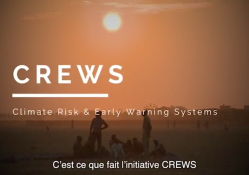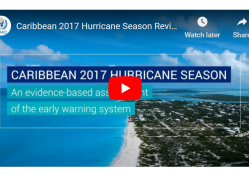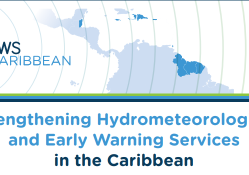The Climate Risk Early Warning Systems (CREWS) Caribbean project works to strengthen and streamline regional and national systems and capacity related to weather forecasting, hydrological services, multi-hazard impact-based warnings and service delivery for enhanced decision-making.
The project features a people-centered approach that prioritizes the inclusion of gender and vulnerable populations such as women, children, the elderly, and persons with disabilities. This requires generating early warning messages and emergency alerts that reach these groups in an effective, timely, and safe manner that meets their special needs and circumstances.
Project activities primarily focus on the 15 Caribbean Community (CARICOM) member countries and are divided into three project components:
- Regional Strategy and Identification of Priority Investments
- Institutional Strengthening and Capacity Building of Hydromet Services and EWS (Early Warning Systems)
- Implementations of National-Level Pilot Projects to Comprehensively Strengthen EWS
The Caribbean is highly exposed to natural hazards, in particular, hydrometeorological phenomena such as hurricanes and tropical storms, floods, landslides, and storm surge, which cause significant damages and losses on a regular basis. A changing climate has brought increased intensity, frequency, spatial extent, and duration of these extreme weather events in the region. For instance, Hurricane Irma in 2017, had Category 5 intensity for 60 hours – the longest duration recorded in the era of weather satellites. The 2020 hurricane season has featured hurricane formation at a record-breaking rate.
While hurricanes are the most frequent cause of disasters, there is a number of other natural phenomena such as earthquakes and tsunamis, causing injuries, deaths, displacement, destruction, and economic losses. And beyond natural hazards, there are health shocks, including and in addition to COVID-19, such as Chicungunya, Dengue, and Zika. Environmental threats such as corral bleaching and sargassum blooms continue to wreak havoc all over the Caribbean region.
Given these frequent and devastating impacts, it is vital that the Caribbean strengthens its timely action through enhanced Early Warning Systems and Services that bring together multiple hazards and have an impact-based focus that centers around the people receiving the warning.
Strengthening Hydromet & Early Warning Services in the Caribbean
Back in 2017, the World Meteorological Organization initiated a review of the Early Warning System in the Caribbean. The evidence-based assessment identified three main findings:
- The need to increase forecasting of secondary hazards such as coastal flooding and flash floods
- More cooperation between National Meteorological and Hydrological Services and Disaster Risk Management institutions
- Caribbean citizens are not aware enough of warnings from weather forecasts and warning offices
These findings, along with the devastating experiences from the 2017 Caribbean hurricane season, concluded that populations at risk do require Early Warning Systems and emergency alerts that provide clearly defined actions and preventive measures to reduce the impact of climate and weather-related hazards. The main findings and lessons learned outlined in the review were incorporated into the CREWS Caribbean project’s design and implementation plan.
In 2018, CREWS Caribbean launched its first phase: designing a strategy to strengthen hydromet and Early Warning Systems in conjunction with regional agencies and global partners. A three-year, US$5.5 million project, CREWS Caribbean aims to strengthen and streamline regional and national systems and capacity related to weather forecasting, hydrological services, multi-hazard impact-based warnings and service delivery for enhanced decision-making.
The project features a people-centered approach that prioritizes the inclusion of gender and vulnerable populations such as women, children, the elderly, and persons with disabilities. This requires generating early warning messages and emergency alerts that reach these groups in an effective, timely, and safe manner that meets their special needs and circumstances.
CREWS Caribbean also emphasizes the importance of trusted, clear, and actionable information in the form of two-way communication and feedback loops. This allows for leaders, coordinators, and participants alike, to learn from experiences, continuously improve, and therefore, save lives and reduce economic losses in the region.
Project activities primarily focus on the 15 Caribbean Community (CARICOM) member countries and are divided into three project components:
Climate Risk Early Warning Systems (CREWS)
In many developing countries, hydrometeorological (or hydromet) services (provision of weather, climate and hydrological information) are inadequate to meet societal needs. This hydromet service gap exists because there is insufficient resourcing of the infrastructure, equipment, and technology required to provide these crucial services.
The Climate Risk Early Warning Systems (CREWS) Global Initiative is a multi-lateral fund that supports these countries by increasing their capacity to generate and communicate effective, impact-based, multi-hazard, gender-informed early warnings to protect lives, livelihoods, and assets.
The French Government launched the CREWS Initiative in 2015. Australia, France, Germany, Luxembourg, the Netherlands, Switzerland and the United Kingdom contribute to the pooled CREWS Trust Fund and provide oversight to CREWS operations through the CREWS Steering Committee.
The CREWS Programming Framework is aligned with international principles for risk-based, people-centered, multi-hazard Early Warning Systems as described in its Operational Procedures. CREWS projects worldwide are measured in the reduction of lives and livelihoods lost to extreme climate event (the Sustainable Development Goals and the Sendai Framework for Disaster Risk Reduction) and contributes to the action agenda of the Paris Climate Agreement.
Why CREWS Caribbean is Timely and Needed
- Increase in climate hazards: Extreme weather events, such as high-powered and destructive hurricanes, continue to displace residents, cause injuries and death, damage infrastructure, and create other climate emergencies.
- High regional demand: Caribbean countries and territories are prioritizing Early Warning System improvements and risk-informed planning to protect their populations from exposure to extreme weather hazards. Building capacity to provide more accurate and timely warnings can make a huge difference in saving lives, as well as protecting infrastructure and economic development gains.
- Multiple expertise and resources: Participating Caribbean countries and territories benefit from the many partners and entities working together to strengthen Early Warning Systems.
Implementing partners include the World Bank (WB) / Global Facility for Disaster Reduction and Recovery (GFDRR), the World Meteorological Organization (WMO), and the United Nations Office for Disaster Risk Reduction (UNDRR). CREWS Caribbean is the first CREWS project to leverage all three of these implementing partners.
The implementing partners work in close collaboration with the following regional partners, in-country collaborating agencies, and consortia.
Regional Partners:
Caribbean Disaster Emergency Management Agency (CDEMA)
Caribbean Meteorological Organization (CMO)
Caribbean Institute for Meteorology and Hydrology (CIMH)
In-Country Collaborating Agencies
National Meteorological and Hydrological Services
National Disaster Management Organizations
Gender Bureaus
Ministries of Finance
Consortia:
Regional Early Warning Systems Consortium
Early Warning Information Systems across Climate Timescales (EWISACTs)
Workshop participants at the Understanding Risk Forum in Barbados (May 2019)
To learn about partnership opportunities, please contact:
The project features a people-centered approach that prioritizes the inclusion of gender and vulnerable populations such as women, children, the elderly, and persons with disabilities. This requires generating early warning messages and emergency alerts that reach these groups in an effective, timely, and safe manner that meets their special needs and circumstances.
CREWS Caribbean also emphasizes the importance of trusted, clear, and actionable information in the form of two-way communication and feedback loops. This allows for leaders, coordinators, and participants alike, to learn from experiences, continuously improve, and therefore, save lives and reduce economic losses in the region.
Project activities primarily focus on the 15 Caribbean Community (CARICOM) member countries and are divided into three project components:
Component 1
The Situation Analysis has been finalized. A regional Roadmap, which is still being developed, will allow the CREWS Caribbean project make the most of all existing initiatives, knowledge, resources, partners, and collaborating agencies in the region. And with more collaboration – among countries and coordinating entities, at the national, regional, and local levels – participating countries are able to significantly strengthen their Multi-hazard Early Warning Systems and Services.
The Roadmap will also feature Strategic Initiatives that will guide the project team to propose regional activities and identify investment opportunities. It will also help advance closer institutional alignment, streamline coordination, and better define division of roles.
Component 2
The Caribbean Meteorological Organization (CMO) has commenced its work in assisting member countries to strengthen governance arrangements. CMO has engaged eight countries to begin developing their National Strategic Plans and Frameworks for Weather, Water & Climate Services. This work is being supplemented by the development of a Model Meteorology Bill. The first phase of this activity has been completed with a draft policy outline, which was drafted before members for their review.
In the area of enhanced product development, accessibility, and service delivery, the project team is overseeing initiatives such as a flash flood guidance system, a severe weather forecast program, and an impact-based forecasting system.
For enhanced service delivery, there has been the hosting of one Caribbean Climate Outlook Forum (CariCOF), with another planned for November 2021. The Guidelines for Coastal Inundation for Small Island Developing States is being finalized. In keeping with the overall commitment to strengthen institutional capacity, two fellowships have been awarded to professionals from the Barbados and Saint Lucia Meteorological Services.
Component 3
The Situation Analysis of the Multi-Hazard Early Warning Systems (MHEWS) in the Caribbean revealed both strengths and weaknesses of the current end-to-end Early Warning System and Services. The Situation Analysis also identified opportunities for enhancing and strengthening the regional MHEWS. Additionally, this assessment provided the basis to develop a regional Roadmap outlining eight Strategic Initiatives, which address key bottlenecks and challenges.
Four of these eight Strategic Initiatives helped identify and design the below pilot activities, which aim to strengthen regional and national capacities, close the gaps in the end-to-end Early Warning Systems, and capture lessons learned.
- Pilot activity 1: Establishment of the Caribbean Operational Plan for Hydromet Hazards
- Pilot activity 2: Development of a Multi-sensor Precipitation Grid
- Pilot activity 3: Support the Transition to Impact-Based Forecasting
- Pilot activity 4: Development of a Regional Emergency Alert System
Project Adjustments Due to the COVID-19 Pandemic
While the COVID-19 pandemic has put on hold almost all in-person missions, trainings, and events, the implementation of most activities has continued virtually or online.
Multi-Hazard Early Warning Systems (MHEWS) address several hazards and/or impacts of similar or different type in contexts where hazardous weather events occur alone, simultaneously, cascadingly, or cumulatively over time.
Given the ability to provide warnings of multiple hazards, MHEWS increase the efficiency and consistency of warnings through coordinated and compatible mechanisms and capacities, which involve multiple disciplines for updated and accurate hazards identification and the monitoring for multiple hazards.
MHEWS feature the participation of multiple stakeholders and actively involve all individuals and neighborhoods at risk. MHEWS also incorporate technology, regulatory and legal frameworks, and operational capacities with clearly defined roles for all participating agencies, organizations, and communities.
For further reading:
Report: Strengthening of Risk Assessment and Multi-Hazard Early Warning Systems in the Caribbean (2011, WMO)

Watch the CREWS Caribbean videos playlist on YouTube
Additional Resources
“The CREWS approach builds community resilience through collaborative, gender-inclusive, cascading Early Warning Systems for the Caribbean region.”
- Edmund Hinkson, Minister of Home Affairs, Barbados





